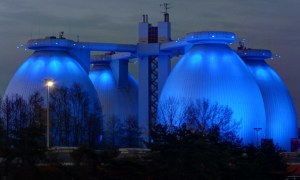🕑 Reading time: 1 minute
Quality checking, handling and installation of sewer sanitary pipes requires utmost care. It is required to employ suitable material quality and appropriate construction practices to construct satisfactory sewer sanitary system. The evaluation of sanitary sewer pipe quality along with its handling and installation practices are discussed in the following sections. Following points regarding sewer pipes are explained:
Following points regarding sewer pipes are explained:
- Sanitary sewer pipe quality
- Handling of sanitary sewer pipe
- Installation practices of sanitary sewer pipe
Contents:
Quality of Sanitary Sewer Pipe
Generally, sewer sanitary pipe producer and independent inspection and testing laboratories are responsible to carry out proper sewer sanitary pipe inspection and testing. Sanitary sewer pipe inspection includes visual inspection of pipe surface finish, workmanship and markings, sanitary sewer pipe thickness, length, diameter and joint tolerances. Representative specimen tests and confirmation of pipe stiffness design material tests in the case of flexible pipes or crushing strength design material tests in the case of rigid pipe are conducted. It is recommended to inspect sanitary sewer pipe at production plant because delivery of unacceptable pipe would increase the total cost of the construction. As far as sanitary sewer precast concrete pipe is concerned, the pipe strength can be estimated using either three edge bearing test, core test or standard cylinder test.
Fig.1: Three Edge Bearing Test on Sewer Pipes
It should be known that standard cylinder test is not suitable with mixes utilized number of production techniques. That is why, core test should be adopted if three edge bearing test is not used. This test would also examine installation tolerances of reinforcing cages. Certificate of compliance with applicable standards should be provided by manufacturer. This certificate is normally checked immediately after the loads of sanitary sewer pipe reach the project site. As sanitary sewer pipes reach construction site, visual inspection should be conducted to check whether the pipes have suffered damages during transportation and similar inspection is needed while it is placed in storage and handled.Handling of Sanitary Sewer Pipes
It is required to practice great cautions while sanitary sewer pipes are handled during loading and transportation to the project site or unloading and storage or installing in the trenches. This is because damages and deterioration of sanitary sewer pipes during these activities due to mishandling is likely to impose high impacts or point loading are highly likely. The entire phases of construction process should be carried out with adequate accuracy to obtain conditions specified according to the design. This will ensure that the loading conditions accounted for in the design will not be exceeded. It is required to specifically pay attention to the joint elements to avoid damages.
Fig.2: Sanitary Sewer Pipe Handling
Installation of Sanitary Sewer Pipes
Sanitary sewer pipe shall be installed on bedding which is strong but show flexibility to a certain extent under pressure. The bedding shall have proper grading and consistent bearing under the whole length of sanitary sewer pipe barrel.
Fig.3: Sanitary Sewer Pipe Installation
The disturbance of placed subgrade should be prevented while pipe joints are fastened. This can be achieved using supports for the pipes and keep it away from subgrade. Proper excavation should be created to accommodate sanitary sewer pipe collar and bells, therefore supports and bottom reactions are merely assigned to sanitary sewer pipe barrel.
Fig.4: Installed Sewer Pipe
Necessary configurations should be done by removing excessive bedding or adding sufficiently consolidated foundations materials beneath sanitary sewer pipe. The use of blocks, wedging, and hitting sewer pipes to realize required adjustments should be strongly prohibited. As far as joining operation are concerned, cleaning of spigots and bells should be ensured and any adhered materials must be removed and eliminated. Joint materials used for various types of sewer pipes are not the same, so each type need certain care and considerations. Therefore, the specified material types and determined jointing procedure should be used for each type of sewer pipe joint. All types of sanitary sewer pipe joints are required to be sufficiently secured and pass exfiltration of infiltration tests. It would be necessary to apply considerable force to insert the spigot of compression type joint of large diameter pipe into the bell. So, it is possible to use a crane, which is employed to handle large sewer sanitary pipe to obtain the required force. Furthermore, activities of machineries over small diameter pipes should be prevented after the pipe jointing. This is because such operations and other similar activities will impose undesired influence on the installed pipes. Sanitary sewer pipes, which have not been installed and lift at construction site at the end of working day, should be sealed properly to keep the pipes clean. And the construction works should not start the next day unless the elevation of last installed pipe is verified. Read More: Design and Construction of Flexible Sewer Sanitary Pipes Special Construction of Sewer Sanitary Pipe System -Methods and Considerations How to Set Up Sewer Sanitary System Layout? Drains and Sewers Terms Definitions Direct Design of Concrete Pipes for Sewer Sanitary Marston-Spangler Load Analysis Theory for Sewer Sanitary System


